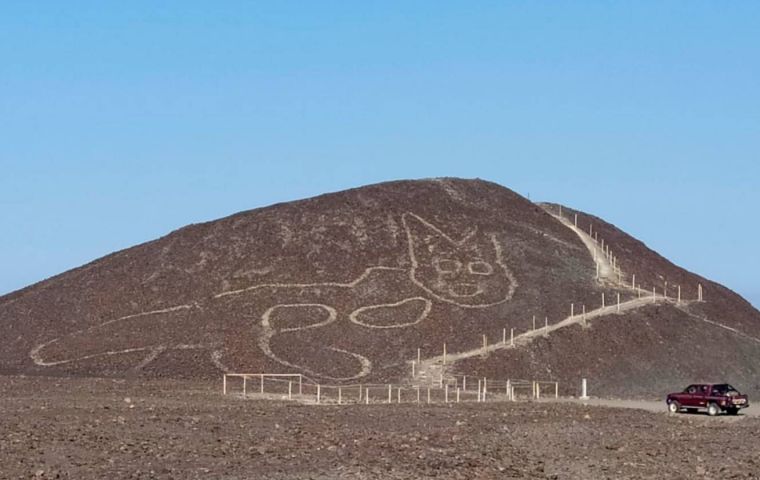MercoPress. South Atlantic News Agency
Peruvian archeologists uncover a 37 meter long cat in the Nazca Lines
 The figure with a long body, striped tail and head with distinctive pointed ears, predates some better known-figures such as a hummingbird, spider and a human
The figure with a long body, striped tail and head with distinctive pointed ears, predates some better known-figures such as a hummingbird, spider and a human Peruvian archaeologists have uncovered a 37-metre-long cat etching in a little-explored area of the country's celebrated Nazca Lines UNESCO heritage site which is home to hundreds of gigantic geoglyphs dating back more than 2,000 years.
The figure, made up of a long body, striped tail and head with distinctive pointed ears, predates some of the area's better known-figures that include a hummingbird, spider and a human, the country's Culture Ministry said.
It is one of a number discovered in recent years by drone exploration of the protected 400-square-kilometre region that lies some 450km south of the capital Lima between the towns of Nazca and Palpa.
Johny Isla, the ministry's specialist for the Nazca-Pampa region, said it was estimated to be around 2,000 years old and made up of groves carved into the mountain coupled with groupings of stones.
“The figure was in the process of disappearing because it was on a slope that was subject to quite extensive erosion which resulted in it being hidden for many years,” he told Reuters Television.
The geoglyph has been painstakingly cleaned and preserved by a team of archaeologists to make it more easily visible, the ministry said in a statement, adding that the discovery was “further evidence of the rich and varied cultural legacy” of the area.
The Nazca Lines, which can only be seen from the air, include etchings of a monkey, spider, pelican, whale, dog and lizard.
The geoglyphs created by the Nazca and Paracas cultures are striking reminders of Peru's rich pre-Columbian history and are considered archaeological enigmas, as no one knows for sure why they were drawn, or so large and for so long.




Top Comments
Disclaimer & comment rulesCommenting for this story is now closed.
If you have a Facebook account, become a fan and comment on our Facebook Page!